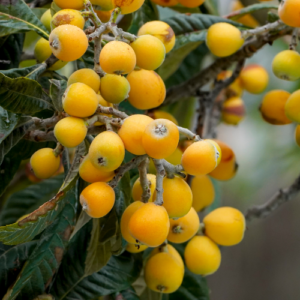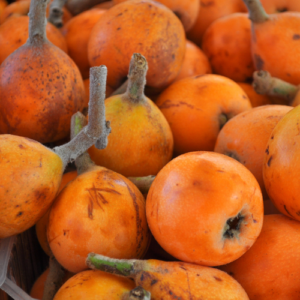THE LOQUAT TREE
In local dialect “Nespolo di Maggio”
Eriobotrya japonica (Thunb.) Lindl.
Rosaceae
🌳 A TREE WITH ORIENTAL CHARM
- The loquat tree differs completely from the medlar, even though it is sometimes referred to as Japanese medlar. We included the loquat tree in our orchard of forgotten fruits to highlight the differences between the two, just as we did with wild sour cherries and cherries.
- Native to China, the loquat tree first spread to Japan and later to the Mediterranean region. Today, it thrives especially in southern Italy, Spain and Greece.
🌳 Evergreen tree: this medium-sized tree grows up to 4-6 meters in height, and it has a rounded, dense crown.
🍃Leathery leaves: They are dark green on the upper side and tomentose (covered with fine, white fuzz) on the underside.
🌸Fall blooming: Small, white-cream flowers with a fragrant scent bloom between October and December.
🍑Fruit (loquat): It is an orange or golden pome, very juicy and sweet, with a soft, fragrant pulp.
🌱Strong roots: It adapts well to different soil types, and it is drought tolerant.
☀️ Ideal climate: It prefers mild climates and is sensitive to late frosts, which can compromise fruiting.

😆 INTERESTING FACTS
- The fruit is so sweet and juicy that in some Italian regions it is called “spring honey.”. 🍯
- In Spain, it is used to produce a liqueur called “Níspero”, while in Sicily it is traditionally used to make homemade syrups and jams.
- If ingested in large quantities, loquat seeds are toxic. However, in the past, people would carry them in their pockets as lucky charms. 🍀
📜 SYMBOL OF WISDOM AND LONGEVITY
- In Japan and China, the loquat tree symbolizes wisdom, fertility and immortality.
- Its evergreen leaves represent resistance and stability, and its winter blooming is seen as a symbol of strength in the face of adversity.
- According to ancient Chinese texts, its leaves and fruits were believed to have miraculous medicinal properties, and they were used to treat cough and respiratory problems.

These contents were written and researched by the owners of the SiGi Agricultural Company in collaboration with the students of the Agricultural Technical Institute of Macerata.
If you would like to contribute to expanding the descriptions of these varieties, you can send an e-mail to info@agricolasigi.it
We launched the e-museum of ancient fruits thanks to a social farming project of the Marche region. The translation is by komalingua
This project enabled five young people with cognitive impairments, aged 20 to 25, to work on the farm. They were selected by psychologists and Anffas social workers, supported by the professional educator Il Faro and supervised by UniMc researchers. Coldiretti Marche handled communication and distribution.
This unique and challenging project led to the creation of both a physical and virtual museum of ancient fruits in SiGi’s garden. This is not only a great honor but also a significant commitment that we are willing to continue with everyone’s support. You can contribute to our projects by choosing our products, or you can do so directly here:

